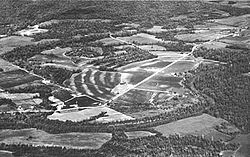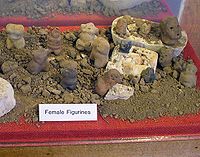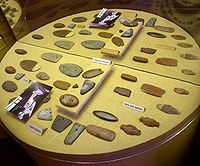
Poverty Point culture
Encyclopedia

Archaeological culture
An archaeological culture is a recurring assemblage of artifacts from a specific time and place, which are thought to constitute the material culture remains of a particular past human society. The connection between the artifacts is based on archaeologists' understanding and interpretation and...
that corresponds to an ancient group of Indigenous peoples
Indigenous peoples of the Americas
The indigenous peoples of the Americas are the pre-Columbian inhabitants of North and South America, their descendants and other ethnic groups who are identified with those peoples. Indigenous peoples are known in Canada as Aboriginal peoples, and in the United States as Native Americans...
who inhabited the area of the lower Mississippi Valley and surrounding Gulf coast from about 2200 BCE - 700 BCE. Archeologists have identified more than 100 sites as belonging to this culture, which engaged in a large trading network throughout the eastern part of what is now the United States.
History
Dating of the Watson BrakeWatson Brake
Watson Brake is an archaeological site in Ouachita Parish, Louisiana from the Archaic period. Dated to about 5400 years ago , Watson Brake is considered the earliest mound complex in North America. It is the earliest dated, complex construction in the Americas...
site in present-day Ouachita Parish, Louisiana
Ouachita Parish, Louisiana
-National protected areas:* Black Bayou Lake National Wildlife Refuge* D'Arbonne National Wildlife Refuge -Demographics:As of the census of 2000, there were 147,250 people, 55,216 households, and 38,319 families residing in the parish. The population density was 241 people per square mile...
, where eleven earthwork mounds were built beginning about 3500 BCE, shows it to be the earliest, dated mound complex in the Americas. It was begun well before the construction of the pyramids in Egypt.
Next oldest is the Poverty Point Culture, which thrived from 2200 BCE- 700 BCE, during the late Archaic period in the Americas. Evidence of this mound builder culture has been found at more than 100 sites, including the Jaketown Site
Jaketown Site
Jaketown Site is an archaeological site with two prehistoric earthwork mounds in Humphreys County, Mississippi, United States. While the mounds have not been excavated, distinctive pottery sherds found in the area lead scholars to date the mounds' construction and use to the Mississippian culture...
near Belzoni, Mississippi
Belzoni, Mississippi
Belzoni is a city in Humphreys County, Mississippi, in the Mississippi Delta region, on the Yazoo River. The population was 2,663 at the 2000 census. It is the county seat of Humphreys County...
. The largest and best-known site is at Poverty Point
Poverty Point
Poverty Point is a prehistoric earthworks of the Poverty Point culture, now a historic monument located in the Southern United States. It is from the current Mississippi River, and situated on the edge of Maçon Ridge, near the village of Epps in West Carroll Parish, Louisiana.Poverty Point...
, which lies on the Macon Ridge near present day Epps, Louisiana
Epps, Louisiana
Epps is a village in West Carroll Parish, Louisiana, United States. The population was 1,153 at the 2000 census.The Poverty Point National Monument is located nearby, the most complex earthworks site built by a Late Archaic culture....
. The Poverty Point culture may have hit its peak around 1500 BCE. It is one of the oldest complex cultures, and possibly the first tribal culture, in the Mississippi Delta
Mississippi Delta
The Mississippi Delta is the distinctive northwest section of the U.S. state of Mississippi that lies between the Mississippi and Yazoo Rivers. The region has been called "The Most Southern Place on Earth" because of its unique racial, cultural, and economic history...
and in the present-day United States. The people occupied villages that extended for nearly 100 miles (160.9 km) on either side of the Mississippi River.
Poverty Point culture was followed by the Tchefuncte and Lake Cormorant cultures of the Tchula period, a local manifestation of the Early Woodland period
Woodland period
The Woodland period of North American pre-Columbian cultures was from roughly 1000 BCE to 1000 CE in the eastern part of North America. The term "Woodland Period" was introduced in the 1930s as a generic header for prehistoric sites falling between the Archaic hunter-gatherers and the...
. These descendant cultures differed from Poverty Point culture in trading over shorter distances, creating less massive public projects, completely adopting ceramics for storage and cooking, and lacking a lapidary
Lapidary
A lapidary is an artist or artisan who forms stone, mineral, gemstones, and other suitably durable materials into decorative items such as engraved gems, including cameos, or cabochons, and faceted designs...
(stone-carving) industry.
Earthworks
Although the earthworksEarthworks (archaeology)
In archaeology, earthwork is a general term to describe artificial changes in land level. Earthworks are often known colloquially as 'lumps and bumps'. Earthworks can themselves be archaeological features or they can show features beneath the surface...
at Poverty Point
Poverty Point
Poverty Point is a prehistoric earthworks of the Poverty Point culture, now a historic monument located in the Southern United States. It is from the current Mississippi River, and situated on the edge of Maçon Ridge, near the village of Epps in West Carroll Parish, Louisiana.Poverty Point...
are not the oldest in the United States, (the earthworks at Watson Brake
Watson Brake
Watson Brake is an archaeological site in Ouachita Parish, Louisiana from the Archaic period. Dated to about 5400 years ago , Watson Brake is considered the earliest mound complex in North America. It is the earliest dated, complex construction in the Americas...
were built about 1900 years earlier) they are notable as the oldest earthworks of this size in the Western Hemisphere. In the center of the site is a plaza, a constructed and leveled, flat, open area covering about 15 hectares or 37 acres (149,733.8 m²). Archeologists believe the plaza was the site of public ceremonies, rituals, dances, games and other major community activities.
The site has six concentric earthworks separated by ditches, or swales, where dirt was removed to build the ridges. The ends of the outermost ridge are 1204 metres (3,950.1 ft) apart, which is nearly 3/4 of a mile. The ends of the interior embankment are 594 metres (1,948.8 ft) apart. If the ridges were straightened and laid end to end, they would comprise an embankment of 12 kilometres (7.5 mi) long. Originally, the ridges stood 4 feet (1.2 m) to 6 feet (1.8 m) high and 140 feet (42.7 m) to 200 feet (61 m) apart. Many years of plowing have reduced some to only 1 foot (0.3048 m) in height. Archeologists believe that the homes of 500 to 1,000 inhabitants were located on these ridges.
This was the largest settlement at that time in North America. The site also had a 50 feet (15.2 m) high, 500 feet (152.4 m) long earthen pyramid
Pyramid
A pyramid is a structure whose outer surfaces are triangular and converge at a single point. The base of a pyramid can be trilateral, quadrilateral, or any polygon shape, meaning that a pyramid has at least three triangular surfaces...
, which was aligned east to west. A large bird effigy mound
Effigy mound
Sites in the U.S. of similar history may be found at Indian Mounds ParkAn effigy mound is a raised pile of earth built in the shape of a stylized animal, symbol, religious figure, or human figure. Effigy mounds were only built during the Late Woodland Period .Effigy mounds were constructed in many...
, measuring 70 feet (21.3 m) high and 640 feet (195.1 m) across, is also located on the Poverty Point site.
On the western side of the plaza, archeologists have found some unusually deep pits. One explanation is these holes once held huge wooden posts, which served as calendar markers. Using the sun’s shadows, the inhabitants could have predicted the changing of the seasons. This great building project demanded a sustained investment of human labor, the organized skill and the cultural will to sustain the effort over many centuries. One authority calculated that it would take more than 1236007 cubic feet (34,999.8 m³) of basket-loaded soil to complete the earthworks. That would mean 1,350 adults laboring 70 days a year for three years.
Artifacts


Another type of artifact, crude human figures, are thought to have been used for magical purposes. Points made of imported gray Midwestern flint
Flint
Flint is a hard, sedimentary cryptocrystalline form of the mineral quartz, categorized as a variety of chert. It occurs chiefly as nodules and masses in sedimentary rocks, such as chalks and limestones. Inside the nodule, flint is usually dark grey, black, green, white, or brown in colour, and...
were also found. In addition, plummets were fashioned out of heavy iron
Iron
Iron is a chemical element with the symbol Fe and atomic number 26. It is a metal in the first transition series. It is the most common element forming the planet Earth as a whole, forming much of Earth's outer and inner core. It is the fourth most common element in the Earth's crust...
ore imported from Hot Springs, Arkansas
Hot Springs, Arkansas
Hot Springs is the 10th most populous city in the U.S. state of Arkansas, the county seat of Garland County, and the principal city of the Hot Springs Metropolitan Statistical Area encompassing all of Garland County...
; they served as weights for fish nets. Many of the raw materials used, such as slate
Slate
Slate is a fine-grained, foliated, homogeneous metamorphic rock derived from an original shale-type sedimentary rock composed of clay or volcanic ash through low-grade regional metamorphism. The result is a foliated rock in which the foliation may not correspond to the original sedimentary layering...
, copper
Copper
Copper is a chemical element with the symbol Cu and atomic number 29. It is a ductile metal with very high thermal and electrical conductivity. Pure copper is soft and malleable; an exposed surface has a reddish-orange tarnish...
, galena
Galena
Galena is the natural mineral form of lead sulfide. It is the most important lead ore mineral.Galena is one of the most abundant and widely distributed sulfide minerals. It crystallizes in the cubic crystal system often showing octahedral forms...
, jasper
Jasper
Jasper, a form of chalcedony, is an opaque, impure variety of silica, usually red, yellow, brown or green in color; and rarely blue. This mineral breaks with a smooth surface, and is used for ornamentation or as a gemstone. It can be highly polished and is used for vases, seals, and at one time for...
, quartz
Quartz
Quartz is the second-most-abundant mineral in the Earth's continental crust, after feldspar. It is made up of a continuous framework of SiO4 silicon–oxygen tetrahedra, with each oxygen being shared between two tetrahedra, giving an overall formula SiO2. There are many different varieties of quartz,...
, and soapstone
Soapstone
Soapstone is a metamorphic rock, a talc-schist. It is largely composed of the mineral talc and is thus rich in magnesium. It is produced by dynamothermal metamorphism and metasomatism, which occurs in the areas where tectonic plates are subducted, changing rocks by heat and pressure, with influx...
, were from as far as 620 miles (997.8 km) away, attesting to the distant reach of the trading culture.
The Poverty Point culture developed a tradition of making high-quality, stylized, carved and polished miniature stone beads. Other early cultures in eastern North America rarely used stone to make their beads, opting for softer materials such as shell or bone. The fine cutting, engraving and polishing lapidary work done by these people resulted in refined and unique art forms. They made the beads in the images of many different animals that were common to their environment, such as an owl, dog, locust, and turkey vulture.
See also
- Poverty PointPoverty PointPoverty Point is a prehistoric earthworks of the Poverty Point culture, now a historic monument located in the Southern United States. It is from the current Mississippi River, and situated on the edge of Maçon Ridge, near the village of Epps in West Carroll Parish, Louisiana.Poverty Point...
- Archaeological periods of the Mississippi Valley - a chronological table of the cultures and phases

